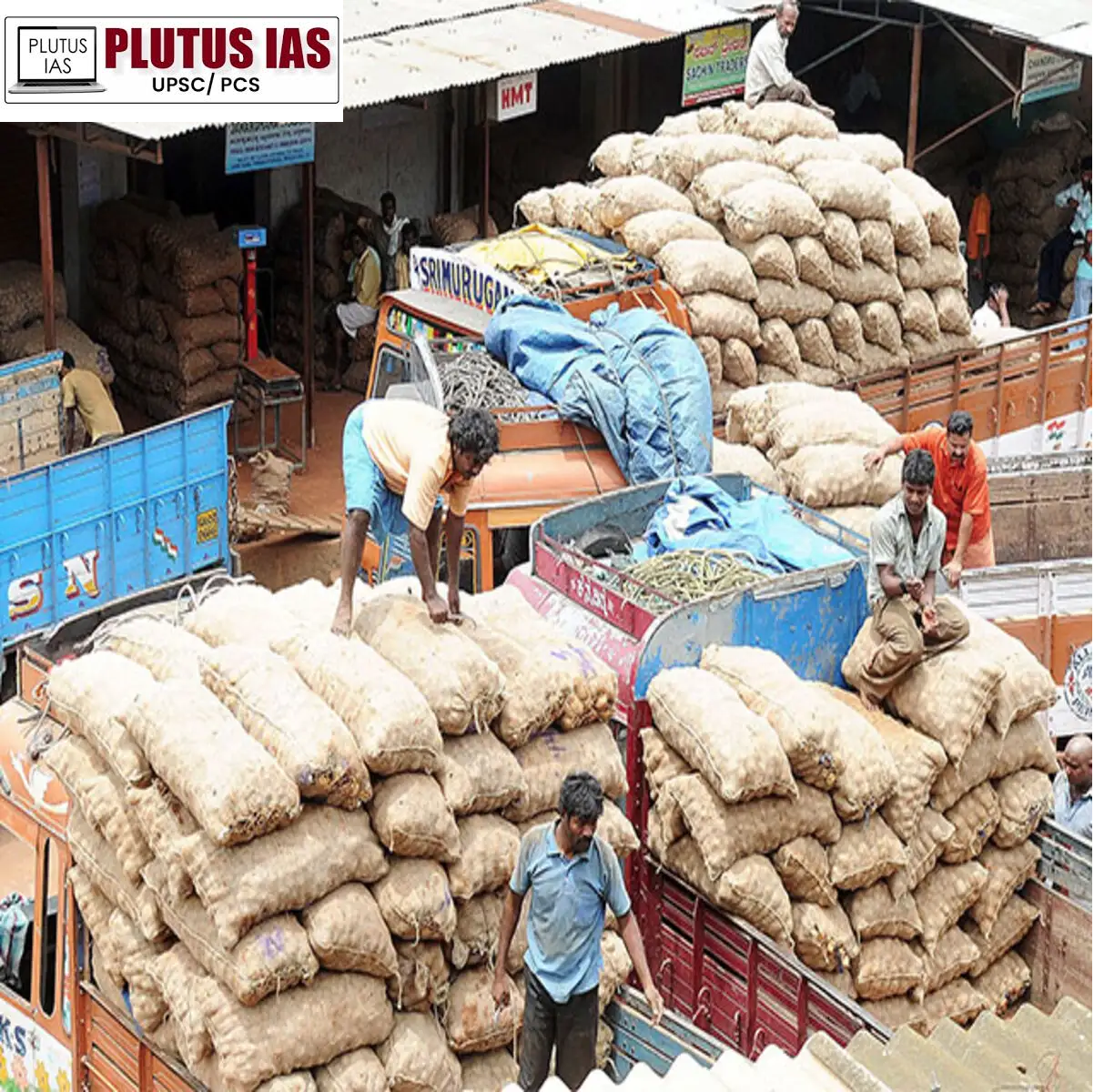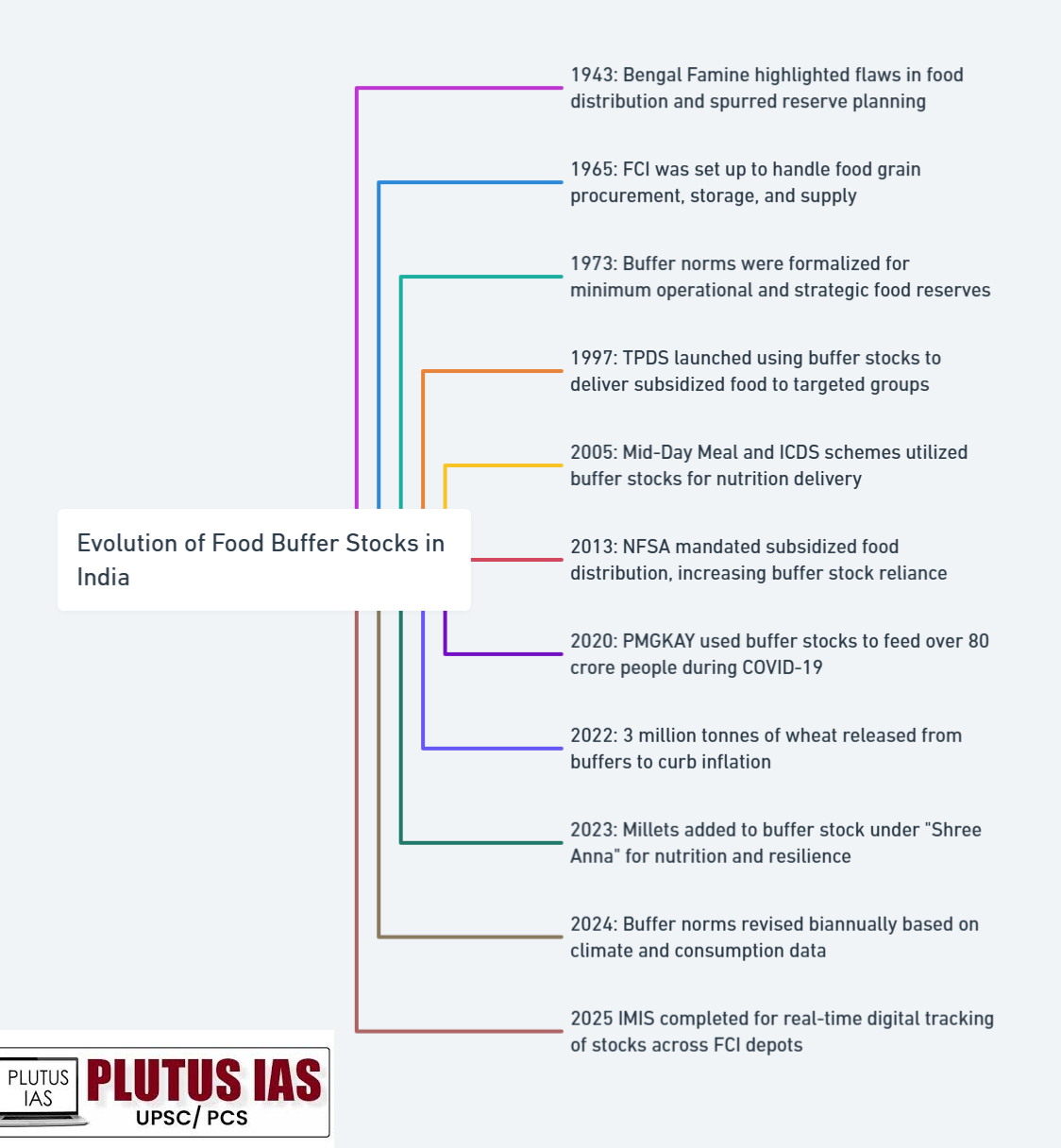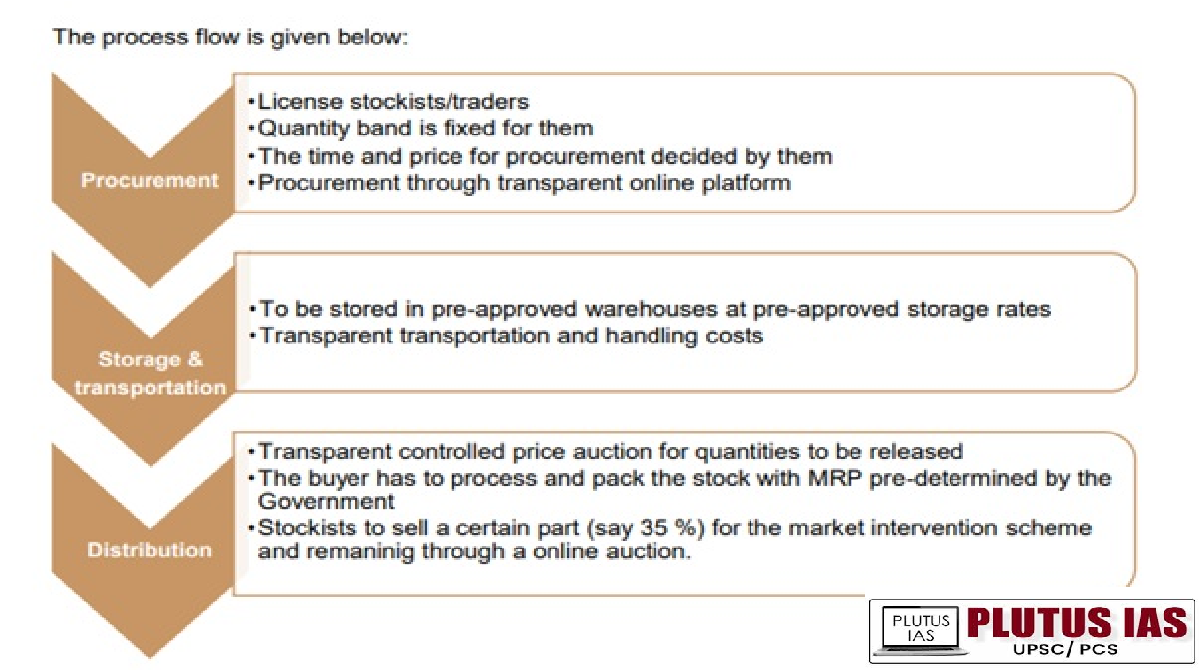06 May Buffer Stock in India: A Strategic Necessity in Food Security
This article covers “Daily Current Affairs” and the Topic Buffer Stock in India: A Strategic Necessity in Food Security
SYLLABUS MAPPING:
GS-03- Food Security : Buffer Stock in India: A Strategic Necessity in Food Security
FOR PRELIMS
The role of the Food Corporation of India (FCI), impact of schemes like PMGKAY and TPDS on the utilization and replenishment of buffer stock.
FOR MAINS
Challenges associated with large-scale foodgrain storage in India, Suggest sustainable solutions.
Why in the News?
The Government of India has approved the engagement of a professional pulses buffer management entity to streamline the handling of national pulse reserves. As of February 1, 2017, nearly 9.71 lakh tonnes of pulses were procured through domestic and import channels. Although no single state requested one lakh tonnes, around 50,958 tonnes were allocated based on aggregate state demands. This move comes amid efforts to stabilize prices and ensure timely availability. With adequate storage capacity via the Central Warehousing Corporation (CWC), the initiative reflects the Centre’s push for a responsive, data-driven buffer stock policy.

What is Buffer Stock?
Buffer stock refers to a reserve of essential commodities, primarily food grains like wheat and rice, maintained by the government to ensure food security, stabilize prices, and manage emergencies such as crop failures or natural disasters. These stocks are procured at Minimum Support Prices (MSP) and managed by agencies like the Food Corporation of India (FCI).
Evolution of Buffer Stock in India
The concept of buffer stocking in India emerged in the aftermath of the 1960s food crisis, particularly during the Green Revolution. The Food Corporation of India (established in 1965) was mandated to procure, store, and distribute food grains under the Public Distribution System (PDS). Over time, buffer norms were established, and stock levels were institutionalized to cater to consumption needs and emergency requirements. The National Food Security Act (NFSA), 2013 further formalized the role of buffer stocks in ensuring subsidized food distribution to over 800 million people.

Why We Need Buffer Stock
1.Price Stabilization: Buffer stocks play a critical role in stabilizing prices by absorbing market shocks. For instance, in 2022, FCI released 3 million tonnes of wheat from central pools to check rising retail prices.
2. Ensuring Food Security: During crises like COVID-19, over 800 million people received free food grains under the PM Garib Kalyan Anna Yojana (PMGKAY), highlighting the importance of buffer stock in food access.
3. Natural Disaster Response: In flood-hit Assam (2022), emergency food grain releases from buffer stock ensured uninterrupted PDS supply to over 5 lakh affected families.
4. Public Distribution System (PDS) Backbone: Buffer stock ensures monthly distribution of 5 kg food grains per person to NFSA beneficiaries, covering 75% rural and 50% urban populations.
5. Strategic Reserve Against Global Disruptions: In 2023, amidst global wheat export bans, India’s domestic buffer helped contain food inflation without relying on imports.
6. Support to Farmers through MSP: Procurement at MSP ensures income support to farmers. In 2022-23, FCI procured over 105 million tonnes of food grains benefiting over 1.5 crore farmers.
7. Nutrition and Crop Diversification Push: Including pulses and millets under buffer norms, such as in the ‘Shree Anna’ millet initiative (GoI, 2023), helps improve diet quality and sustainability.
What Are the Issues with Buffer Stock
1. Storage Inefficiencies: A significant portion of buffer stocks is stored in substandard warehouses, leading to spoilage due to moisture, rodents, and lack of ventilation. According to a 2022 CAG report, FCI lost over 2.5 lakh tonnes of food grains to wastage over five years.
2. Mounting Fiscal Burden: The cost of procuring, transporting, and storing food grains under MSP often surpasses budgetary allocations. The food subsidy bill crossed ₹2.87 lakh crore in FY 2022-23, as per Union Budget documents.
3. Over-Procurement and Imbalance: Procurement is often skewed towards wheat and rice, especially from Punjab and Haryana, ignoring regional crop diversity. This leads to nutritional gaps and stockpile inefficiencies.
4. Environmental Degradation: Continuous procurement of water-intensive crops like paddy promotes unsustainable groundwater use. Punjab, contributing over 30% of central rice stocks, faces critical water table depletion.
5. PDS Leakages and Corruption: Despite reforms, leakages continue in the PDS system. The Economic Survey 2021-22 estimated leakage rates in some states as high as 25%, resulting in grain diversion.
6. Quality Degradation: Long-term storage affects grain quality, leading to undernutrition and wastage. A 2020 FCI audit highlighted over 10% of stocks becoming unfit for human consumption annually.
7. Lack of Dynamic Buffer Policies: Buffer norms are not always aligned with real-time demand or climate fluctuations. For instance, excess stocks during COVID-19 led to challenges in distribution due to mobility restrictions, showing the need for more flexible norms.

Ways to Make Efficient Use of Buffer Stock
2. Decentralized Procurement: Encouraging state-level procurement as per local crop patterns reduces transportation costs and promotes local farming communities. States like Chhattisgarh and Odisha have successfully implemented decentralized procurement models under the NFSA.
3. Dynamic Buffer Norms: Revising buffer stock norms periodically based on demand trends, climate variations, and production forecasts helps prevent excessive accumulation. The Department of Food and Public Distribution now reviews these norms bi-annually.
4. Improved Targeting in PDS: Use of Aadhaar-based authentication, One Nation One Ration Card (ONORC), and end-to-end digitization ensures targeted delivery. According to the Ministry of Consumer Affairs, ONORC has enabled 93 crore portability transactions.
5. Diversification of Stock: Including pulses, millets, and edible oils in buffer stocks supports nutritional security and promotes sustainable agriculture. The government’s initiative to procure millets under the ‘Shree Anna’ campaign is a step in this direction.
6. Public-Private Partnerships (PPPs): Collaborating with private players for warehousing, logistics, and stock rotation enhances efficiency. Warehousing Development and Regulatory Authority (WDRA) has facilitated over 2,000 registered private warehouses as of 2024.
7. Transparent and Real-Time Monitoring: Establishing real-time dashboards for stock levels and movements can improve accountability and decision-making. The FCI’s Integrated Management Information System (IMIS) is now operational in all major depots.
Conclusion
Buffer stock management remains a cornerstone of India’s food security architecture. While it has played a vital role in shielding millions from hunger and inflation, systemic inefficiencies and financial burdens necessitate urgent reforms. Through technological modernization, better targeting, and strategic diversification, buffer stocks can evolve into a more efficient and sustainable instrument of national resilience and food justice.
Download Plutus IAS Current Affairs (Eng) 06th May 2025
Prelims Questions
Q. Consider the following statements:
1. Buffer norms in India are revised annually.
2. The National Food Security Act (NFSA), 2013 increased dependence on buffer stock.
Which of the above is/are correct?
(a) 1 only
(b) 2 only
(c) Both 1 and 2
(d) Neither 1 nor 2
ANSWER: B
Mains Questions
Q.Discuss the evolution of the buffer stock policy in India since independence. How has it adapted to the changing needs of food security? (250 words, 15 marks)




No Comments